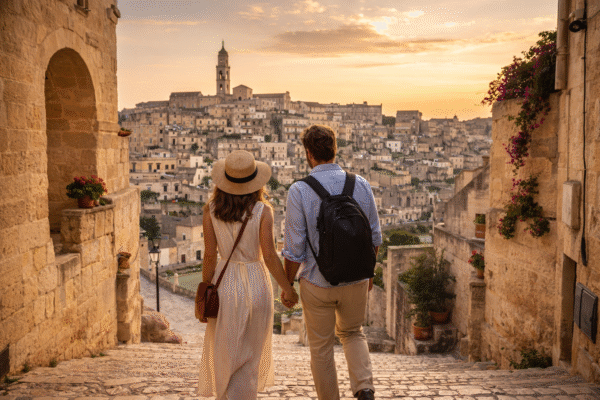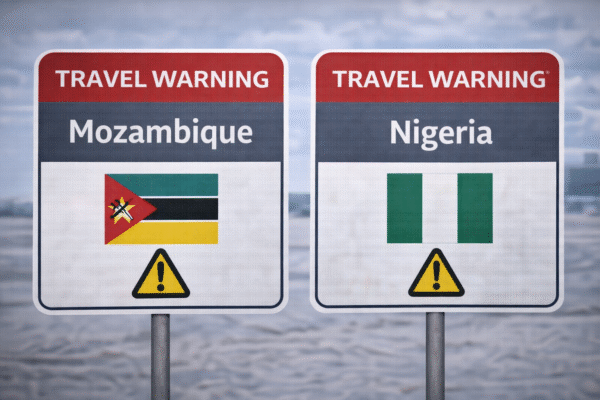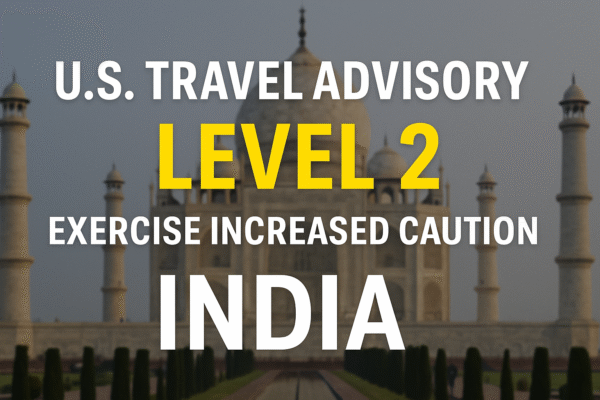July 21, 2025 — NEW DELHI, India — The U.S. Department of State has updated its travel advisory for India to Level 2: Exercise Increased Caution, citing elevated risks of violent crime, sexual assault, and potential terrorist activity in certain regions. The advisory, issued on July 16, 2025, encourages American travelers to remain vigilant when visiting the country and highlights concerns over safety, particularly for women and solo travelers.
While the warning is not a restriction on travel, it serves as a cautionary note for U.S. citizens to carefully assess travel plans, especially when visiting rural and high-risk areas.
What a Level 2 Advisory Means for India
The State Department uses a four-level advisory system ranging from Level 1 (“Exercise Normal Precautions”) to Level 4 (“Do Not Travel”). India’s Level 2 classification reflects a moderate warning and places it alongside other frequently visited destinations like Morocco, South Africa, and the Philippines.
According to the U.S. Embassy in New Delhi, this advisory was issued following a routine reassessment of India’s internal security climate. The report highlights increased incidents of violent crime, including rape and sexual assault, which remain significant threats in both urban and rural areas. The advisory specifically warns travelers against venturing into remote or poorly lit locations, especially at night.
Areas of Concern: Where Travelers Should Be Cautious
The updated notice outlines specific regions and states where U.S. government personnel must obtain special authorization prior to traveling. These areas have been flagged due to elevated threats from both crime and extremist groups:
- Bihar
- Jharkhand
- Chhattisgarh
- West Bengal (rural areas)
- Odisha
- Meghalaya
In particular, the region extending from eastern Maharashtra and northern Telangana to western West Bengal is identified as a high-risk corridor where crime and insurgent activity remain concerns.
Travel to state capitals such as Patna, Ranchi, Raipur, Bhubaneswar, and Kolkata is generally permitted, but areas outside of these urban centers may pose additional risks to tourists.
Women’s Safety Highlighted as a Priority Concern
One of the most pressing issues highlighted by the U.S. advisory is the safety of women, particularly solo female travelers. India continues to struggle with high-profile incidents of gender-based violence, with rape listed among the fastest-rising crimes in the country, according to the National Crime Records Bureau of India.
The advisory recommends that women:
- Avoid traveling alone, particularly after dark.
- Book accommodations with verified safety ratings.
- Use trusted transportation services like Uber or pre-paid taxis.
- Consider traveling in groups or with local guides.
U.S. citizens are also urged to register with the Smart Traveler Enrollment Program (STEP) to receive safety updates and emergency assistance.
Terrorism and Border Area Security
While major cities such as Delhi, Mumbai, and Bangalore remain relatively secure, the State Department warns of continued threats in border regions and remote areas, especially near Pakistan, Myanmar, and Northeast India.
Though terrorist attacks have decreased in frequency, low-intensity threats, demonstrations, and insurgent violence still occur. U.S. citizens are discouraged from participating in large public gatherings, protests, or visiting politically sensitive zones without proper guidance.
Indian Government Responds
India’s Ministry of External Affairs (MEA) responded to the updated travel advisory by stating it is “not reflective of the broader security landscape” of the country. Indian officials noted that the U.S. has maintained a Level 2 advisory for India for several years and emphasized that millions of international tourists visit without incident.
Tourism authorities further underscored that India’s tourism industry has implemented extensive security measures at key destinations, especially in states like Goa, Kerala, Rajasthan, and Himachal Pradesh, which are less affected by the issues raised in the advisory.
Tourism Sector Continues to Grow
Despite the advisory, India’s appeal as a global travel destination remains strong. In 2023, the country welcomed 9.24 million international tourists, a 43.5% increase from the previous year, fueled by post-pandemic travel demand and government-led initiatives such as Dekho Apna Desh and Incredible India 2.0.
However, the advisory could prompt American travelers—particularly women and solo tourists—to reconsider their itineraries, delay trips, or opt for travel packages with enhanced security assurances.
According to a Travel and Tourism Economic Impact report by WTTC, India’s tourism sector is expected to contribute $250 billion to GDP by 2030, emphasizing the importance of maintaining international traveler confidence.
Tips for Travelers Visiting India
To stay safe and enjoy a hassle-free experience in India, travelers should:
- Research regional risks and stay updated with travel advisories.
- Enroll in STEP (Smart Traveler Enrollment Program).
- Use registered accommodations with high guest ratings.
- Stay connected with embassy alerts and local authorities.
- Carry copies of passport and visa documents.
- Avoid border areas, remote forests, or regions with insurgency activity.
Final Thoughts
India remains a diverse, culturally rich, and spiritually vibrant destination, drawing millions of global travelers annually. While the Level 2 U.S. advisory highlights real risks, it does not prohibit travel—only encourages increased awareness.
With the right planning and precautions, travelers can still enjoy India’s majestic landscapes, ancient temples, modern cities, and world-class heritage sites safely.
For those considering travel, it is essential to stay informed, respect local customs, and follow trusted security guidance. Tourism in India is evolving—and with strategic efforts from both government and private sectors, ensuring visitor safety will be key to long-term growth.
For more travel news like this, keep reading Global Travel Wire



















